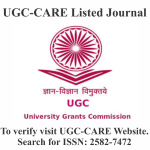IMPACT OF COVID-19 VACCINE ON PEOPLE: A CASE STUDY
DOI:
https://doi.org/10.29121/shodhkosh.v5.i1.2024.3534Keywords:
Covid-19, Vaccine, Health, Impacts, Collaborative ApproachAbstract [English]
The research explores the multifaceted impact of COVID-19 vaccines on physical, mental, and social well-being among residents of Mumbai, India. It examines the effectiveness of vaccines in mitigating severe illness and hospitalizations while highlighting the physical side effects and their management. Mental health dynamics are analyzed, emphasizing reduced anxiety and improved perceptions of safety post-vaccination, though some individuals reported persistent stress and concerns. Socially, the study reveals enhanced participation in group activities and improved community resilience, yet notes challenges in addressing misinformation and vaccine hesitancy. A mixed-method approach was employed, combining secondary data and primary survey responses from individuals aged 18-50. The survey captured experiences with physical side effects, emotional changes, and perceptions of vaccine rollout efficiency. Key findings include a high vaccination rate (97.3%) among respondents, with Covishield being the most administered vaccine. Despite minor side effects, most respondents managed them effectively through rest and hydration. Social dynamics shifted positively, with increased confidence in engaging in public and social activities. The study also underscores disparities in vaccine access and the need for targeted communication strategies to counter misinformation. Recommendations emphasize prioritizing mental health through transparent communication, equitable vaccine distribution, and addressing logistical barriers. The study concludes by advocating for a collaborative approach involving governments, healthcare providers, and communities to enhance vaccine acceptance and efficacy, thereby mitigating the pandemic's multifaceted impact.
References
Hu, Y., Sun, J., Dai, Z., et al. (2020). Prevalence and severity of coronavirus disease 2019 (COVID‐19): A systematic review and meta‐analysis. Journal of Clinical Virology. DOI: https://doi.org/10.1016/j.jcv.2020.104371
Machhi, J., Herskovitz, J., Senan, A. M., et al. (2020). The natural history, pathobiology, and clinical manifestations of SARS‐CoV‐2 infections. Journal of Neuroimmune Pharmacology. DOI: https://doi.org/10.1007/s11481-020-09944-5
U.S. Bureau of Labor Statistics. (2019). Number of hospitals and hospital employment in each state in 2019. The Economics Daily. U.S. Bureau of Labor Statistics.
World Health Organization. (n.d.). Coronavirus disease (COVID-2019) press briefings. World Health Organization.
Zhu, N., Zhang, D., Wang, W., et al. (2020). A novel coronavirus from patients with pneumonia in China, 2019. New England Journal of Medicine. DOI: https://doi.org/10.1056/NEJMoa2001017
Zou, L., Ruan, F., Huang, M., et al. (2020). SARS‐CoV‐2 viral load in upper respiratory specimens of infected patients. New England Journal of Medicine. DOI: https://doi.org/10.1056/NEJMc2001737
Downloads
Published
How to Cite
Issue
Section
License
Copyright (c) 2024 Dr. Amrita Aggarwal

This work is licensed under a Creative Commons Attribution 4.0 International License.
With the licence CC-BY, authors retain the copyright, allowing anyone to download, reuse, re-print, modify, distribute, and/or copy their contribution. The work must be properly attributed to its author.
It is not necessary to ask for further permission from the author or journal board.
This journal provides immediate open access to its content on the principle that making research freely available to the public supports a greater global exchange of knowledge.




















